| A computer list, as its name implies, is a list of computers. You can think of computer lists as groups for computers. If you want to manage preferences based on computers, you do so by using computer lists. In Workgroup Manager, you can add any Mac OS X computer to the computer list based on its hardware Ethernet address or Media Access Control (MAC) address. You may have as many computer lists as you want, but a computer may be in only one list. Any computer outside of a list is automatically in the Guest Computers list. Windows computers have their own list (discussed in the task "To manage the Windows Computers list"). You can configure computer lists on any Mac OS X Server. However, computer lists are only functional on the server acting as an Open Directory master, because such servers are configured to share their directory information with other computers. Also, your client computers must be configured as clients of this directory service system. For more information about directory services and Open Directory, refer to Chapter 3, "Open Directory." To create a computer list: 1. | Launch the Workgroup Manager tool located in /Applications/Server, and authenticate as the administrator (Figure 13.1).
Figure 13.1. Launch Workgroup Manager, and authenticate. 
| 2. | Click the Accounts icon  in the Toolbar and the Computer Lists tab in the Toolbar and the Computer Lists tab  among the account types (Figure 13.2). among the account types (Figure 13.2).
Figure 13.2. Select the Computer Lists tab to manage computer lists. 
| 3. | Click the directory authentication icon  , and select the appropriate directory database from the pop-up menu. , and select the appropriate directory database from the pop-up menu.
Computer lists are always hosted from a parent directory database (Figure 13.3).
Figure 13.3. Select the appropriate directory database from this pop-up menu. 
| 4. | Click the New Computer List button  . .
The information in the List frame is populated with a new untitled computer list (Figure 13.4).
Figure 13.4. Add a new computer list. 
| 5. | Enter an appropriate computer list name (Figure 13.5).
Figure 13.5. Enter your computer list's name. 
| 6. | To add computers to this computer list, do either of the following:
Click the Add button  , and an edit dialog will drop from the title bar (Figure 13.6). Enter the computer's Ethernet address, name, and optional comment in the appropriate fields. When you've finished, click the Save button , and an edit dialog will drop from the title bar (Figure 13.6). Enter the computer's Ethernet address, name, and optional comment in the appropriate fields. When you've finished, click the Save button  . . Figure 13.6. The computer list edit dialog lets you add or modify a computer in your computer list. 
Click the ellipsis button  , and a browse dialog will open (Figure 13.7). Browse to and select the computer you wish to add to this list, and then click the Connect button , and a browse dialog will open (Figure 13.7). Browse to and select the computer you wish to add to this list, and then click the Connect button  . . Figure 13.7. The browse dialog automatically discovers Mac OS X computers on your local network. 
| 7. | Verify that the computers have been added to your computer list (Figure 13.8).
Figure 13.8. A few computers have been added to this computer list. 
| 8. | When you've finished making changes, click the Save button  . .
|
To modify a computer list: 1. | Launch the Workgroup Manager tool located in /Applications/Server, and authenticate as the administrator (Figure 13.9).
Figure 13.9. Launch Workgroup Manager, and authenticate. 
| 2. | Click the Accounts icon  in the Toolbar and the Computer Lists tab in the Toolbar and the Computer Lists tab  among the account types, and select the list you wish to edit (Figure 13.10). among the account types, and select the list you wish to edit (Figure 13.10).
Figure 13.10. Select the Computer Lists tab to manage computer lists. 
| 3. | If it isn't already selected, click the List tab  . .
| 4. | Do either of the following:
Double-click the computer list item you wish to edit, and enter the new value (Figure 13.11). When you've finished, press Enter or click anywhere else. Figure 13.11. Modify any item in the computer list by double-clicking the appropriate field. 
Select a computer from the Computers list, and then click the Edit button  to open the computer list edit dialog. to open the computer list edit dialog.
| 5. | To delete a computer from the list, select it from the Computers list, and then click the Delete button  . .
|
To delete a computer list account: 1. | Select the computer list account from the Accounts list.
| 2. | Click the Delete button  (Figure 13.12). (Figure 13.12).
Figure 13.12. Select the computer list account, and then click the Delete button. 
|
 Tips Tips
You can have up to 2,000 computers in a computer list. You may wish to explore the restricted workgroup access settings, the cache settings, and the managed preference settings for your computer list. Refer to the remaining tasks in this chapter for more information. You can select more than one item in a list by holding down the Shift or Command key while making your selections. As is the case for user and group accounts, you can use account presets to automatically configure new computer lists. See Chapter 4, "User and Group Management," for more information.
The Guest Computers list Any Mac OS X computer that isn't defined in a custom computer list automatically uses the settings from the Guest Computers list. Generally, it's considered bad practice to allow any of your managed computers to fall into the Guest Computers list, because you should reserve this list for computers you don't want to manage. Take great care with your choices in the Guest Computers list, or you may inadvertently control computers you didn't intend to manage. To manage the Guest Computers list: 1. | Launch the Workgroup Manager tool located in /Applications/Server, and authenticate as the administrator (Figure 13.13).
Figure 13.13. Launch Workgroup Manager, and authenticate. 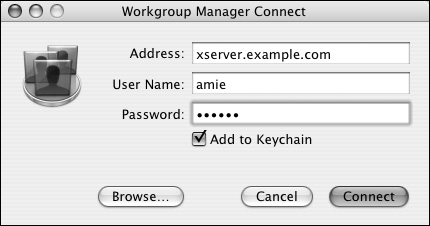
| 2. | Click the Accounts icon  in the Toolbar and the Computer Lists tab in the Toolbar and the Computer Lists tab  among the account types (Figure 13.14). among the account types (Figure 13.14).
Figure 13.14. Select the Computer Lists tab to manage computer lists. 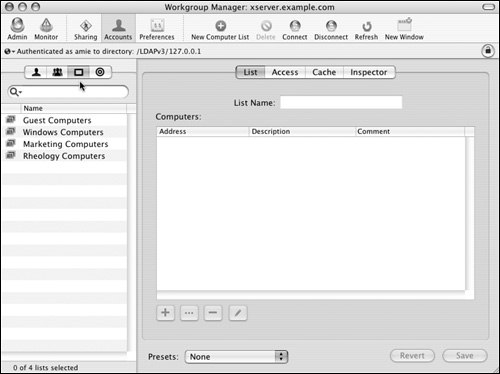
| 3. | Click the directory authentication icon  , and select the appropriate directory database from the pop-upmenu. , and select the appropriate directory database from the pop-upmenu.
Computer lists are always hosted from a parent directory database (Figure 13.15).
Figure 13.15. Select the appropriate directory database from this pop-up menu. 
| 4. | From the accounts list, select Guest Computers (Figure 13.16).
Figure 13.16. Select Guest Computers from the computer account list. 
| 5. | Click the Lists tab  , and then choose one of the following options: , and then choose one of the following options:
"Inherit preferences for Guest Computers" is the default setting. Guest computers will inherit their managed preferences from your Open Directory server (Figure 13.17). Figure 13.17. The Guest Computers List frame lets you set the Inherited preference option. 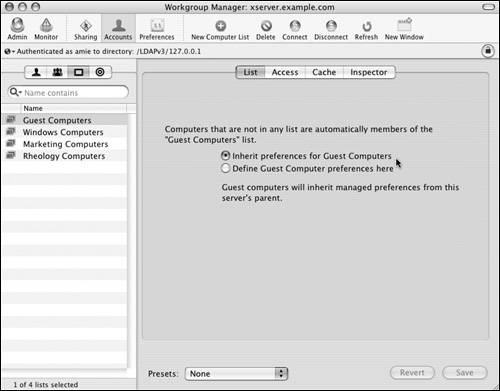
"Define Guest Computer preferences here" means you wish to configure specific managed preferences for guest computers. This option lets you configure restricted workgroup access settings, cache settings, and managed preference settings for guest computers (Figure 13.18). Figure 13.18. The Guest Computers List frame lets you set the Defined preference option. 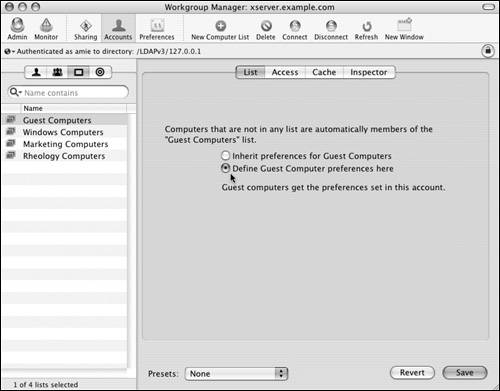
| 6. | When you've finished making changes, click the Save button  . .
|
 Tip Tip
You may wish to explore the restricted workgroup access settings, the cache settings, and the managed preference settings for this computer list. Refer to the remaining tasks in this chapter for more information.
The Windows Computers list One of the default computer lists automatically created by the server tools is the Windows Computers list. If your Mac OS X Server is configured as a Windows Primary Domain Controller (PDC), any Windows client supported by your server needs to be in this list. (See Chapter 5, "File Sharing," for more information about configuring your Mac OS X Server as a PDC.) Windows computers can be in only one list, and there is only this one list for Windows, so they all appear here. The first time a Windows client joins your server's PDC, it's automatically added to this list. However, you can also manually configure Windows computers in this list using the instructions in the following task. To manage the Windows Computers list: 1. | Launch the Workgroup Manager tool located in /Applications/Server, and authenticate as the administrator (Figure 13.19).
Figure 13.19. Launch Workgroup Manager, and authenticate. 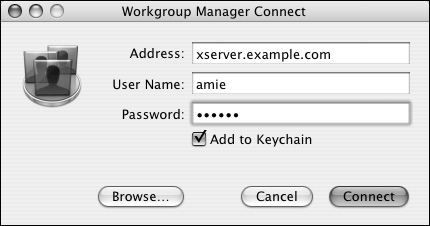
| 2. | Click the Accounts icon  in the Toolbar and the Computer Lists tab in the Toolbar and the Computer Lists tab  among the account types (Figure 13.20). among the account types (Figure 13.20).
Figure 13.20. Select the Computer Lists tab to manage computer lists. 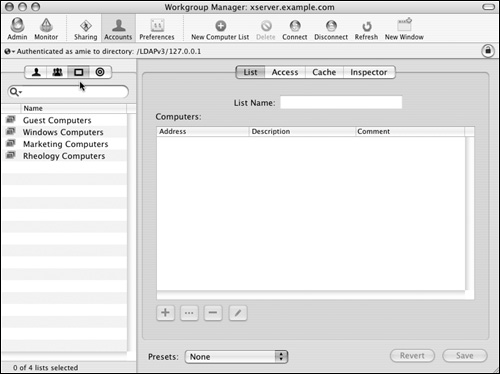
| 3. | Click the directory authentication icon  , and select the appropriate directory database from the pop-upmenu. , and select the appropriate directory database from the pop-upmenu.
Computer lists are always hosted from a parent directory database (Figure 13.21).
Figure 13.21. Select the appropriate directory database from this pop-up menu. 
| 4. | From the accounts list, select the Windows Computers account (Figure 13.22).
Figure 13.22. Select the Windows Computers account from the computer accounts list. 
You can only manage the computer list in the Windows Computers frame; all the other tab options are grayed out. Also, any Windows computer that has already joined your server's PDC is automatically added to this list (Figure 13.23).
Figure 13.23. The Windows Computers List frame in Workgroup Manager lets you manage a list of Windows computers. 
| 5. | To manually add a Windows computer, click the Add button  . .
An edit dialog drops from the title bar (Figure 13.24).
Figure 13.24. The Windows Computers List edit dialog lets you add Windows computer. 
| 6. | Enter the Windows computer's NetBIOS name and an optional description in the appropriate fields.
Click the Save button  . .
| 7. | Verify that the Windows computer has been added to your computer list (Figure 13.25).
Figure 13.25. A few Windows computers have been added to this computer list. 
| 8. | When you've finished making changes, click the Save button  . .
|
 Tips Tips
You can't modify the NetBIOS name of a Windows computer in the list. You can, however, modify the description by double-clicking the description you wish to edit and entering the new value (Figure 13.26). When you've finished, press Enter or click anywhere else. Figure 13.26. Modify the Windows computer description in the list by double-clicking the appropriate field. 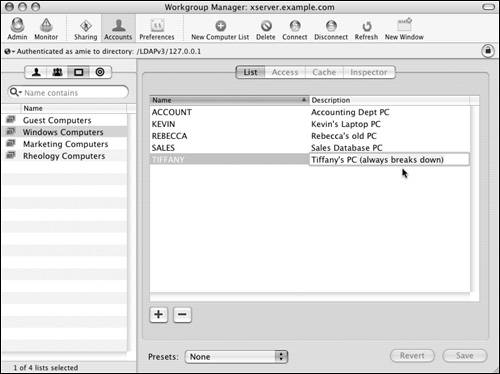
To delete a computer from the list, select it from the Windows Computers list and then click the Delete button  . Don't delete the entire Windows Computers list! . Don't delete the entire Windows Computers list! Windows uses NetBIOS names to identify client computers. These names are typically in all uppercase letters and limited to 25 characters. You can try to apply managed preference settings for these Windows computers, but they will ignore your settings. Windows is so different from Mac OS X that Workgroup Manager settings don't apply to Windows computers.
Restricting login access By default, any user in any group can log in to any client computer that is connected to your directory system. You can restrict user logins to your computers by combining computer lists with workgroups. In Workgroup Manager, you restrict user login to certain workgroups of users for a computer list. In other words, you assign users to workgroups, and then you assign workgroups to computer lists. Obviously, in order for this approach to work, you must have already configured workgroups and computer lists. See Chapter 4, "User and Group Management," for more information. You can also find detailed information about managing computer lists earlier in this chapter. To restrict login access: 1. | Launch the Workgroup Manager tool located in /Applications/Server, and authenticate as the administrator (Figure 13.27).
Figure 13.27. Launch Workgroup Manager, and authenticate. 
| 2. | Click the Accounts icon  in the Toolbar and the Computer Lists tab in the Toolbar and the Computer Lists tab  among the account types (Figure 13.28). among the account types (Figure 13.28).
Figure 13.28. Select the Computer Lists tab to manage computer lists. 
| 3. | Click the directory authentication icon  , and select the appropriate directory database from the pop-up menu. , and select the appropriate directory database from the pop-up menu.
Computer lists are always hosted from a parent directory database (Figure 13.29).
Figure 13.29. Select the appropriate directory database from this pop-up menu. 
| 4. | From the accounts list, select the computer list for which you wish to configure restricted workgroup access (Figure 13.30).
Figure 13.30. Select the computer list for which you wish to configure restricted workgroup access. 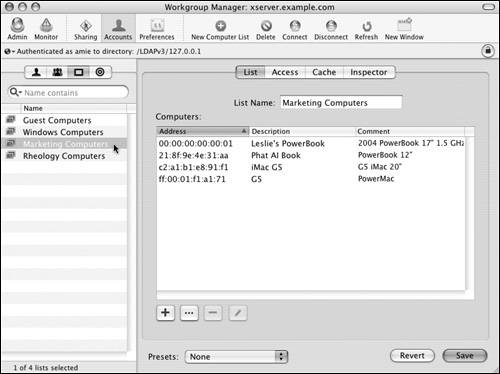
| 5. | Click the Access tab  to view this computer list's workgroup access settings. to view this computer list's workgroup access settings.
By default, any user belonging to any workgroup can log in to the computers in this list (Figure 13.31).
Figure 13.31. The computer account's Access frame lets you add workgroups to the computer account's access list. 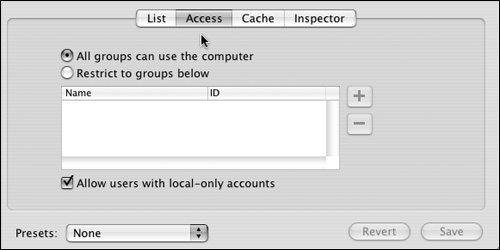
| 6. | Select the "Restrict to groups below" radio button, and then click the Add button  . .
A drawer appears in which you can select the workgroups you wish to assign to this computer list (Figure 13.32).
Figure 13.32. In this drawer, you can select workgroup accounts. 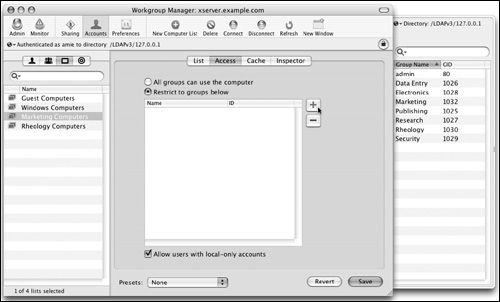
| 7. | At the top of the drawer, click the directory authentication icon, and select the appropriate directory database from the pop-up menu.
The directory you are currently managing will be the default selection and, most likely, will be the one you want to use (Figure 13.33).
Figure 13.33. Select the appropriate directory database from this pop-up menu. 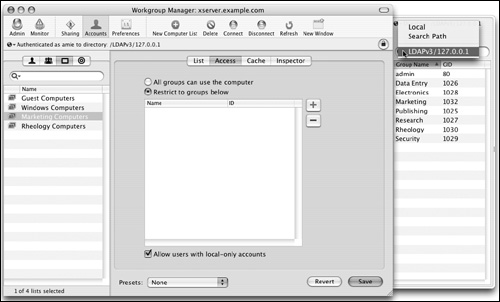
| 8. | Click and drag workgroups from the drawer to the restricted groups list (Figure 13.34).
Figure 13.34. Drag and drop workgroups into the computer account's access list. 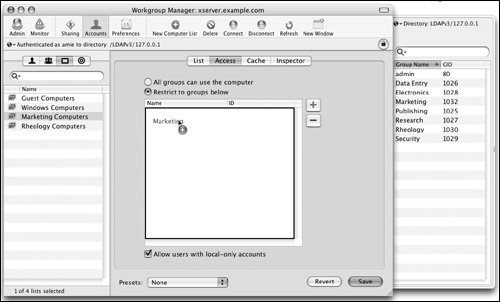
| 9. | When you've finished making changes, click the Save button  . .
Now, when a user attempts to log in, their account will be compared to the workgroups assigned to the computer list this computer is in. If the user isn't part of a workgroup allowed to use this computer, then they won't be allowed to log in. If they belong to one of the allowed workgroups, they will continue to log in as normal. However, if a user belongs to more than one workgroup, they will be required to specify which workgroup they want to use for this session.
|
 Tips Tips
You can select more than one item in a list by holding down the Shift or Command key while making your selections You can further restrict login access to the computers in this list by disabling their access to local accounts. To enable this feature, deselect the "Allow users with local-only accounts" check box (Figure 13.35). Figure 13.35. Disable local computer accounts by deselecting the "Allow users with local-only accounts" check box. 
Configuring computer caches To facilitate computers that may occasionally disconnect from your directory server, like laptops, and to improve directory service performance, managed preference settings are cached locally on client computers. In Workgroup Manager, you can configure how often this cache is automatically updated to the client if any changes are made on the parent directory server. Otherwise, the next time a user logs in to an account, the new account settings will be read, and the local cache file will be updated. To configure computer cache settings: 1. | Launch the Workgroup Manager tool located in /Applications/Server, and authenticate as the administrator (Figure 13.36).
Figure 13.36. Launch Workgroup Manager, and authenticate. 
| 2. | Click the Accounts icon  in the Toolbar and the Computer Lists tab in the Toolbar and the Computer Lists tab  among the account types (Figure 13.37). among the account types (Figure 13.37).
Figure 13.37. Select the Computer Lists tab to manage computer lists. 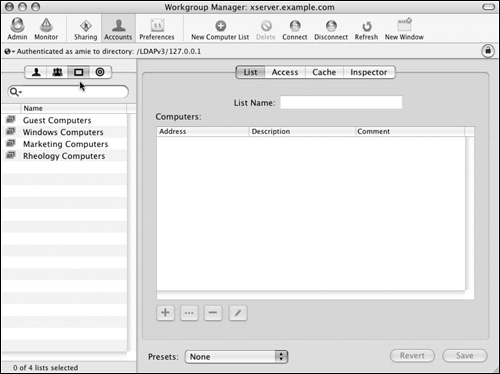
| 3. | Click the directory authentication icon  , and select the appropriate directory database from the pop-up menu. , and select the appropriate directory database from the pop-up menu.
Computer lists are always hosted from a parent directory database (Figure 13.38).
Figure 13.38. Select the appropriate directory database from this pop-up menu. 
| 4. | From the accounts list, select the computer list for which you wish to configure cache settings (Figure 13.39).
Figure 13.39. Select the computer list for which you wish to configure cache settings. 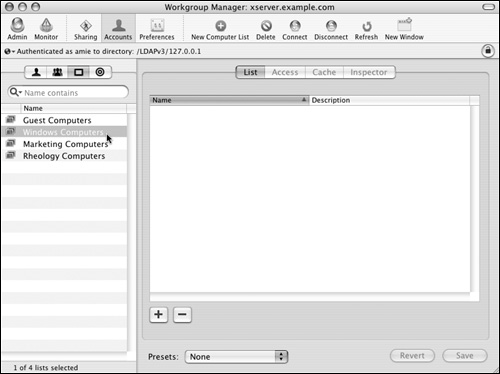
| 5. | Click the Cache tab  to view this computer list's cache settings. to view this computer list's cache settings.
By default, the cache is set to reset every two days (Figure 13.40).
Figure 13.40. The computer account's Cache frame lets you configure a computer account's cached preference settings. 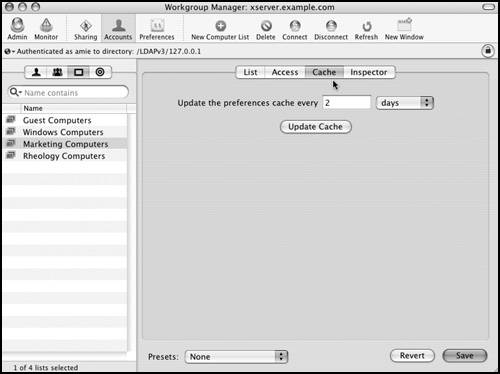
| 6. | To change the cache intervals, enter a different value in the appropriate field, and then select a unit of time from the pop-up menu (Figure 13.41).
Figure 13.41. Select an appropriate time frame from this pop-up menu. 
| 7. | To immediately update the cache files on the computers in this list, click the Update Cache button  . .
| 8. | When you've finished making changes, click the Save button  . .
The cache files will be automatically updated based on the schedule you set or whenever a user logs in.
|
 Tips Tips
To update the cached preferences on a client computer, hold down the Shift key when you log in. When a dialog appears, click the Refresh Preferences button to update the cached preference information. You can select more than one item in a list by holding down the Shift or Command key while making your selections.
|












 Tips
Tips



























